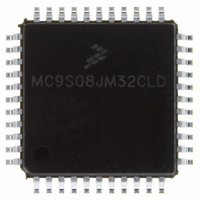MC9S08JM32CLD Freescale Semiconductor, MC9S08JM32CLD Datasheet - Page 200

MC9S08JM32CLD
Manufacturer Part Number
MC9S08JM32CLD
Description
IC MCU 8BIT 32K FLASH 44-LQFP
Manufacturer
Freescale Semiconductor
Series
HCS08r
Datasheet
1.MC9S08JM32CLD.pdf
(388 pages)
Specifications of MC9S08JM32CLD
Core Processor
HCS08
Core Size
8-Bit
Speed
48MHz
Connectivity
I²C, LIN, SCI, SPI, USB
Peripherals
LVD, POR, PWM, WDT
Number Of I /o
33
Program Memory Size
32KB (32K x 8)
Program Memory Type
FLASH
Ram Size
2K x 8
Voltage - Supply (vcc/vdd)
2.7 V ~ 5.5 V
Data Converters
A/D 8x12b
Oscillator Type
External
Operating Temperature
-40°C ~ 85°C
Package / Case
44-LQFP
Processor Series
S08JM
Core
HCS08
Data Bus Width
8 bit
Data Ram Size
2 KB
Interface Type
SCI/SPI
Maximum Clock Frequency
24 MHz
Number Of Programmable I/os
33
Number Of Timers
8
Maximum Operating Temperature
+ 85 C
Mounting Style
SMD/SMT
3rd Party Development Tools
EWS08
Development Tools By Supplier
DEMOJM, DEMOJMSKT, DEMOFLEXISJMSD, DEMO9S08JM16
Minimum Operating Temperature
- 40 C
On-chip Adc
8-ch x 12-bit
Lead Free Status / RoHS Status
Lead free / RoHS Compliant
Eeprom Size
-
Lead Free Status / Rohs Status
Lead free / RoHS Compliant
Available stocks
Company
Part Number
Manufacturer
Quantity
Price
Company:
Part Number:
MC9S08JM32CLD
Manufacturer:
Freescale Semiconductor
Quantity:
1 948
Company:
Part Number:
MC9S08JM32CLD
Manufacturer:
Freescale Semiconductor
Quantity:
10 000
- Current page: 200 of 388
- Download datasheet (5Mb)
Multi-Purpose Clock Generator (S08MCGV1)
The table below shows MCGOUT frequency calculations using RDIV, BDIV, and VDIV settings for each
clock mode. The bus frequency is equal to MCGOUT divided by 2.
This section will include 3 mode switching examples using a 4 MHz external crystal. If using an external
clock source less than 1 MHz, the MCG should not be configured for any of the PLL modes (PEE and
PBE).
12.5.2.1
In this example, the MCG will move through the proper operational modes from FEI to PEE mode until
the 4 MHz crystal reference frequency is set to achieve a bus frequency of 8 MHz. Because the MCG is in
FEI mode out of reset, this example also shows how to initialize the MCG for PEE mode out of reset. First,
the code sequence will be described. Then a flowchart will be included which illustrates the sequence.
200
1. First, FEI must transition to FBE mode:
1
FEI (FLL engaged internal)
FEE (FLL engaged external)
FBE (FLL bypassed external)
FBI (FLL bypassed internal)
PEE (PLL engaged external)
PBE (PLL bypassed external)
BLPI (Bypassed low power internal)
BLPE (Bypassed low power external)
a) MCGC2 = 0x36 (%00110110)
b) Loop until OSCINIT (bit 1) in MCGSC is 1, indicating the crystal selected by the EREFS bit
R is the reference divider selected by the RDIV bits, B is the bus frequency divider selected by the BDIV bits,
and M is the multiplier selected by the VDIV bits.
– BDIV (bits 7 and 6) set to %00, or divide-by-1
– RANGE (bit 5) set to 1 because the frequency of 4 MHz is within the high frequency range
– HGO (bit 4) set to 1 to configure external oscillator for high gain operation
– EREFS (bit 2) set to 1, because a crystal is being used
– ERCLKEN (bit 1) set to 1 to ensure the external reference clock is active
has been initialized.
Example # 1: Moving from FEI to PEE Mode: External Crystal = 4 MHz,
Bus Frequency = 8 MHz
Clock Mode
Table 12-6. MCGOUT Frequency Calculation Options
MC9S08JM60 Series Data Sheet, Rev. 3
(f
(f
f
f
[(f
f
f
f
ext
int
ext
int
ext
int
ext
ext
/ B
/ B
/ B
/ B
/ B
* 1024) / B
/ R *1024) / B
/ R) * M] / B
f
MCGOUT
1
Typical f
immediately after reset. RDIV
bits set to %000.
f
31.25 kHz to 39.0625 kHz
f
31.25 kHz to 39.0625 kHz
Typical f
f
MHz to 2 MHz
f
MHz to 2 MHz
ext
ext
ext
ext
/ R must be in the range of
/ R must be in the range of
/ R must be in the range of 1
/ R must be in the range of 1
MCGOUT
int
= 32 kHz
Note
Freescale Semiconductor
= 16 MHz
Related parts for MC9S08JM32CLD
Image
Part Number
Description
Manufacturer
Datasheet
Request
R
Part Number:
Description:
Manufacturer:
Freescale Semiconductor, Inc
Datasheet:
Part Number:
Description:
Manufacturer:
Freescale Semiconductor, Inc
Datasheet:
Part Number:
Description:
Manufacturer:
Freescale Semiconductor, Inc
Datasheet:
Part Number:
Description:
Manufacturer:
Freescale Semiconductor, Inc
Datasheet:
Part Number:
Description:
Manufacturer:
Freescale Semiconductor, Inc
Datasheet:
Part Number:
Description:
Manufacturer:
Freescale Semiconductor, Inc
Datasheet:
Part Number:
Description:
Manufacturer:
Freescale Semiconductor, Inc
Datasheet:
Part Number:
Description:
Manufacturer:
Freescale Semiconductor, Inc
Datasheet:
Part Number:
Description:
Manufacturer:
Freescale Semiconductor, Inc
Datasheet:
Part Number:
Description:
Manufacturer:
Freescale Semiconductor, Inc
Datasheet:
Part Number:
Description:
Manufacturer:
Freescale Semiconductor, Inc
Datasheet:
Part Number:
Description:
Manufacturer:
Freescale Semiconductor, Inc
Datasheet:
Part Number:
Description:
Manufacturer:
Freescale Semiconductor, Inc
Datasheet:
Part Number:
Description:
Manufacturer:
Freescale Semiconductor, Inc
Datasheet:
Part Number:
Description:
Manufacturer:
Freescale Semiconductor, Inc
Datasheet:











